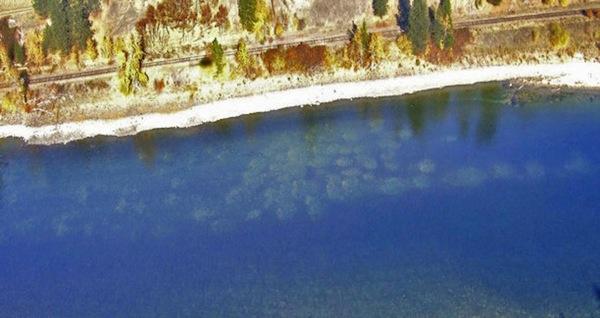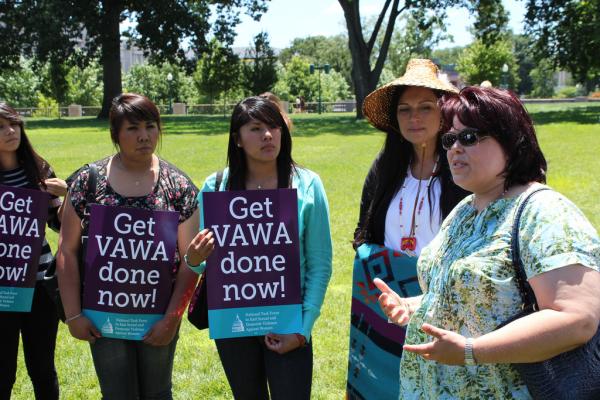Tag: Tribes
Can a Tipi Stop a Pipeline? South Dakota Tribes Stand Firm Against Keystone XL
From the Oglala Lakota Sioux on the Pine Ridge Reservation to the Rosebud Sioux and others, American Indians are standing firm against the Keystone XL pipeline, which would run through or skirt their territory if approved.
The Lakota Sioux have been pushing back against TransCanada, the conglomerate that wants to run the 1,700-mile-long pipeline from the oil sands of Alberta to the Gulf Coast of Mexico, for years. Last week the Rosebud Sioux passed a unanimous resolution against the project. And a group of American Indian tribal leaders opposing the pipeline have vowed to take a “last stand” and are working together, training opponents to put up passive resistance if it comes to that.
“We see what the tar sand oil mining is causing in Canada, we see what the oil drilling in the Dakotas is doing—as they gouge her [Mother Nature] and rape her and hurt her, we know it’s all the same ecosystem that we all need to live in,” Lakota activist and Pine Ridge resident Debra White Plume told Inter Press Service News Agency last month. “For us it’s a spiritual stand—it’s our relative, it hurts us.”
The Rosebud Sioux Tribe approved a resolution on February 25 to reject outright a document that the federal government wants the tribe’s leaders to sign saying that they have been adequately consulted according to the law.
“This Programmatic Agreement for the proposed Keystone XL Pipeline project has not met the standards of Section 106 of the National Historic Preservation Act, because the Rosebud Sioux Tribe has not been consulted,” said Council Representative Russell Eagle Bear in a statement from the tribe. “Additionally, the Cultural Surveys that have been conducted already are inadequate and did not cover adequate on-the-ground coverage to verify known culturally sensitive sites and areas.”
Keystone XL would wend its way through the Great Sioux Nation, including the lands of the Rosebud Sioux Tribe, making them the appropriate tribe to be consulted on land within Tripp, Gregory, Lyman, Todd, and Mellette Counties in South Dakota, the statement said.
“This is a flawed document and it will not be accepted,” Rosebud Sioux Tribal Council President Cyril Scott said of the federal agreement they are being asked to sign. “It is our job as the Tribal Council to take action to protect the health and welfare of our people, and this resolution puts the federal government on notice.”
It is not the first time the government has been accused of fabricating consultation. The first draft of the environmental assessment report, released a year ago, met with resistance from tribes over what they said were inaccuracies, shoddy research and incomplete consultation, among other objections.
The National Congress of American Indians (NCAI) also came out against the conclusions in the draft environmental assessment.
The U.S. Department of State is currently evaluating the final version of the environmental assessment report and accepting input from several federal agencies during a 90-day public comment period that began on January 31, when the report was issued, according to U.S. News & World Report. The State Department is also studying the consultants on the report as more and more revelations about their ties to TransCanada come to light.
RELATED: State Department Investigates Its Own Keystone XL Environmental Consultant
Nearly 400 people, many of them students, were arrested last weekend when they chained themselves to the White House fence in protest of the pipeline, the Washington Post reported.
The Native group Moccasins on the Ground has been conducting training sessions and recently hosted a conference in Rapid City, Help Save Mother Earth from the Keystone Pipeline, to teach civil disobedience tactics.
“As the process of public comment, hearings, and other aspects of an international application continue, each door is closing to protecting sacred water and our Human Right to Water,” said Debra White Plume, a Lakota activist who lives on the Pine Ridge Reservation and has been very vocal in opposing the pipeline, in a statement from Moccasins on the Ground. “Soon the only door left open will be the door to direct action.”
Below, Moccasins on the Ground leaders explain what draws them to protect the sacred water and address the question, Can a tipi stop a pipeline?
Read more at http://indiancountrytodaymedianetwork.com/2014/03/04/can-tipi-stop-pipeline-south-dakota-tribes-stand-firm-against-keystone-xl-153853?page=0%2C1
Fall Chinook Salmon Spawn in Record Numbers in Snake River
Source: Indian Country Today Media Network
Fall Chinook salmon not only returned in droves to spawn in the Snake River Basin, but also created a record number of redds, or nests, that bodes well for the future.
Data culled from several sources show that a record number of salmon spawned in the Snake River Basin in 2013, boosted by a record number of wild fall Chinook that passed Lower Granite Dam, the Columbia River Inter-Tribal Fish Commission (CRITFC) announced on February 25. It was the highest number of wild fish to return since the Ice Harbor Dam was built in 1960.
“The multi-agency run reconstruction of fish returning to Lower Granite Dam revealed 21,000 wild fall Chinook returned to the Snake River in 2013, accounting for 37.5 percent of the total Snake River fall Chinook return of 56,000 fish,” the CRITFC said in a statement. “Over 6,300 redds were created in the Snake River and its tributaries between Lower Granite and Hells Canyon dams. The increase in Snake River returns and the increased distribution in redds were aided by tribal programs that supplement existing Snake River fall Chinook populations.”
Fall Chinook numbers were already surpassing expectations in the Columbia River, with more than a million returning, the CRITFC noted back in September 2013. Moreover, fall 2014 is looking to surpass even that record, with a potential 1.6 million returning, the Lewiston Tribune reported on February 21.
RELATED: Northwest Tribes Exult as Nearly One Million Chinook Return to Columbia River
Now, Northwest tribes are again jubilant at yet another “return of the king,” as Chinook are known. The Snake River return records are being attributed to the success of an innovative hatchery program that intermingles hatchery fish with wild. It was a controversial notion when it was first implemented, but subsequent studies have indicated that the interbreeding does not harm either population.
RELATED: Hatching a Plan for Northwest Salmon: Conference Highlights Fish Stock Restoration
“The Nez Perce Tribe’s Snake River recovery program has resulted in fall chinook returns that the region can truly celebrate,” said CRITFC Chairman and Nez Perce Tribe Executive Committee member Joel Moffett in the statement. “Despite returning to a river noted for hot temperatures and poor passage conditions, these resilient fish were able to spawn in numbers not witnessed in many, many years.”
Every year the Nez Perce Tribe releases 450,000 yearling fall chinook and 2.8 million sub-yearling fall Chinook, the CRITFC said. In all, the broader program releases five million juvenile fish back into the Snake and Clearwater river systems. Since 1990, when the adult fall Chinook return numbered just 78 in the Snake River, the number has increased to 2013’s 21,000 wild adults, the commission said. More information on the ins and outs, as well as the history, of the Nez Perce restoration project is at Snake River Fall Chinook.
RELATED: Fisheries Are the Lifeblood of the Nez Perce Economy
“Abundance is a key to success in the Columbia Basin. The Nez Perce Tribe has shown the Columbia Basin that we can rebuild salmon runs with the assistance of hatcheries,” said CRITFC Executive Director Paul Lumley in the statement. “We are anticipating a lot of fall chinook returning to the Columbia River this year. For anyone wondering why, the answer lies with tribal programs like the Nez Perce Tribe’s Snake River Fall Chinook Program. It is as simple as putting fish back in the rivers and protecting the watersheds where fish live.”
Moffett noted that the record numbers are just the beginning and do not guarantee future success without continued effort.
“This year’s run gives us hope for the future, but we still have a long way to go,” Moffett said. “We must continue to do everything we can to ensure the fish runs continue on this path toward a healthy, self-sustaining population capable of supporting well-managed tribal and non-tribal fisheries. Doing so will ensure the success of this run is repeated in years to come.”
Read more at http://indiancountrytodaymedianetwork.com/2014/03/02/fall-chinook-salmon-spawn-record-numbers-snake-river-153812?page=0%2C1
Indian Affairs Chairman: Education Key For Tribes

By Matthew Brown, Associated Press, 2/19/2014
CROW AGENCY, Mont. (AP) — The new chairman of the U.S. Senate Indian Affairs Committee said Wednesday he plans to use the post to target wasteful spending, improve educational opportunities for Native Americans and promote job development on reservations.
Montana Sen. Jon Tester outlined his agenda for the committee that oversees relations with the nation’s 566 recognized tribes during a visit to the Crow Indian Reservation with fellow Democrat Sen. John Walsh.
After a breakfast meeting with tribal leaders, the pair toured a Head Start education center and later danced with preschoolers around a drum circle.
Crow leaders showed the lawmakers cracks in the ceiling at the preschool and took them to the furnace room where a boiler dating to the 1960s was held together with vise grips to keep it running.
Tester said he was determined to address decades of dysfunction in how the government deals with tribes. He said excessive administrative costs incurred by the Bureau of Indian Affairs, the Indian Health Service and other agencies have drained money from crucial programs including health care and education.
“This is about making sure those dollars that are allocated go to the intended purpose. If there’s waste, eliminate it. And if it means eliminating jobs, then eliminate the jobs,” he said.
Brian Cladoosby, president of the National Congress of American Indians, said problems with the government’s treatment of tribes stem largely from outdated laws and regulations that make Native Americans subservient to federal agencies.
That started to change in recent years — with rules giving tribes more power over their land and property — but further improvements are needed, Cladoosby said.
Tester said too many bureaucratic roadblocks hinder tribes’ attempts to become self-reliant, such as the Crow tribe’s efforts to expand coal mining on the southeastern Montana reservation.
However, Tester added that he would tread carefully to avoid infringing on the sovereignty of West Coast tribes opposed to coal export terminals in Washington and Oregon.
The proposed terminals are key to the coal industry’s aspirations to ship more of the fuel overseas from the Powder River Basin of Montana and Wyoming, in part to make up for flagging domestic demand. Tribes on the West Coast have raised concerns about potential environmental impacts of the shipping.
“I cannot go in and tell another tribe that we’re going to respect the Crow’s sovereignty but we’re not going to respect your sovereignty,” Tester said. “That’s a very dangerous position to put yourself in.”
Despite limits on what the senator can deliver for his home state, Crow leaders said they were pleased to have someone familiar with their concerns assume the influential post of committee chairman.
Crow Secretary A.J. Not Afraid said tribes in Montana and elsewhere on the Great Plains have different needs than tribes in other parts of the country that are closer to population centers and able to bring in significant revenue through gambling.
Those opportunities don’t exist for the Crow, Not Afraid said.
Crow Chairman Darrin Old Coyote said Tester understands the differences.
“He gets it,” Old Coyote said. “He understands our plight and what we’re fighting fo
Government Push for Oil Drives Ecuadorian Tribes to War
Typically, due to a lack of direct representation and a diminished voting base, indigenous groups worldwide are subject to exploitation and a corruption of their rights.
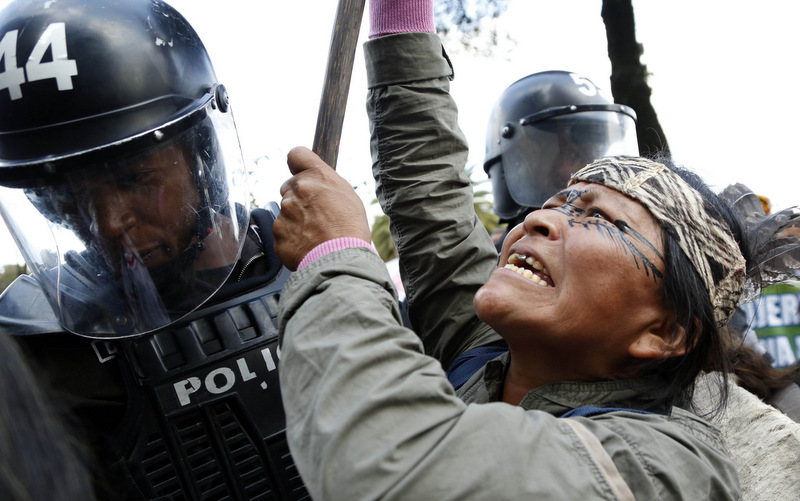
By Frederick Reese, Mint Press News
Ecuador’s broken promise to not drill for oil in the territory of several of the nation’s indigenous people has touched off a tribal war and nearly universal condemnation from the international community.
Ecuador, a member of the Organization of Petroleum Exporting Countries, finds itself forced to find new oil sources to satisfy the nation’s ballooning debt to China. The government’s drilling in Yasuni National Park, one of the world’s most ecologically fragile, has been called inexcusable and reckless by locals for the damage it is causing.
Yasuni National Park is home to many species of flora and fauna that exist nowhere else in the world and to several indigenous tribes that have had no contact to the outside world.
A generation ago, the Waorani (also known as the Huaorani, the Waos or the Waodani) — a culturally-isolated indigenous group, started to find its territory challenged by illegal logging. The situation was made worse by American missionaries who worked to moved the Waorani away from its hunting and gathering traditional existence in the rainforest to permanent villages, such as Yawepare, where the Waorani is forced to live in makeshift shacks with no running water or electricity.
This missionary intervention, coordinated by the Ecuadorian government — cleared large blocks of land around the Auca Road for oil extraction. This has led to major contamination of the drilling sites, due to oil and chemical spills under Texaco management. Chevron, which acquired Texaco, was sued by the Yasuni tribes and was ordered to pay $18 billion in 2011 in restitution. Chevron has rejected the judgment and, as Chevron has no active assets in Ecuador, cannot be forced to pay.
This has created a situation in which those who desperately wish to be left alone have grown dangerously even more desperate. The Taromenane, a voluntarily isolated group that violently resisted the missionaries’ attempt to “civilize” them have allegedly increased its attacks on neighboring tribes. While inter-tribal feuds have existed for generations, they have accelerated with the increased presence of outsiders on its tribal lands.
In one cited example, more than 20 Taromenane, mostly women and children, were killed by the Waorani after a Waorani elder and his wife were allegedly killed by the Taromenane. This happened under the supposed protection of the Ecuadorian government. Two Taromenane girls were kidnapped by the Waorani; Ecuadorian officials were only able to recover the eldest girl, with the youngest still in Waorani custody. According to the tribes involved, this is recognized as being in compliance with their traditional mode of justice.
“I protest because it is my home,” said Alicia Cahuiya, a Waorani leader who was invited to speak to the National Assembly after the Assembly voted to open drilling in the Yasuni National Forest.
After Ecuadorian President Rafael Correa won re-election in March, he proposed the opening of drilling in the Yasuni but offered to postpone to leave the oil in the ground if the international community donated the $3.6 billion his country would have lost in revenue. In August, Correa abandoned this plan when only $17 million was donated.
“Yes, there is oil there, but I do not agree with the oil exploitation. We should be consulted about Yasuní. Our elders do not agree with any of this,” Cahuiya said. “Why are the Taromenane tribe people being killed fighting the Huaorani? Because you opened a road into the jungle! We don’t want any of that! Let us live like Waoranis. That is what we want!”
Typically, due to a lack of direct representation and a diminished voting base, indigenous groups worldwide are subject to exploitation and a corruption of their rights. Due to this, many indigenous groups have been hit with rampant poverty, lack of essential services and denial of legal access and protection.
Coast Salish Nations Unite to Protect Salish Sea
The Lummi, Swinomish, Suquamish and Tulalip tribes of Washington, and the Tsleil-Waututh, Squamish and Musqueam Nations in British Columbia stand together to protect the Salish Sea. Our Coast Salish governments will not sit idle while Kinder Morgan’s proposed TransMountain Pipeline, and other energy-expansion and export projects, pose a threat to the environmental integrity of our sacred homelands and waters, our treaty and aboriginal rights, and our cultures and life ways.
The Salish Sea is one of the world’s largest and unique marine water inland seas. It is home to the aboriginal and treaty tribes of the Northwest whose shared ecosystem includes Washington State’s Puget Sound, the Strait of Juan de Fuca, the San Juan Islands, British Columbia’s Gulf Islands and the Strait of Georgia.
In December 2013, Kinder Morgan, the third largest energy producer in North America, filed an application with the National Energy Board (“NEB”) of Canada to build a new pipeline to transport additional crude oil from the tar sands of Alberta to Vancouver, B.C., where it will be put on tanker vessels and shipped to Asia. The NEB is the Canadian federal agency that regulates energy.
If approved, the proposal would result in expanded transport of crude oil from approximately 300,000 to 890,000 barrels per day. This is a 200 percent increase in oil tanker traffic through the waters of the Salish Sea. Vessel groundings, accidents, leaks, and oil spills are not only possible, they are inevitable.
New jobs and economic growth are being touted as incentives to justify the expansion of the Northwest as the “gateway to the Pacific.” But good fishing and tourism jobs will be lost that depend on a healthy and intact environment. If these projects are approved, the potentially catastrophic effects to our environment and cultural resources will put our Northwest way of life in jeopardy.
In addition to the Kinder Morgan proposal, other port projects and expansions seek to increase the cumulative export of raw fossil fuels from the Salish Sea region to the Asian Pacific and beyond.
As the first peoples of the Salish Sea, it is our responsibility to ensure that our ancestral fishing and harvesting grounds are not reduced to a glorified highway for industry. Each of these proposals represents a potential new threat to our treaty rights in the traditional fishing areas of the Coast Salish tribes and nations. These are rights that the United States promised to protect when they signed treaties with the tribes, recognizing our inherent right to fish “at usual and accustomed grounds and stations.” (1855 Treaty of Point Elliott, Article 5.)
Our relatives to the east, on the sacred Columbia River, are fighting similar battles against dirty fuel projects that threaten to pollute their lands and waters. The Nez Perce stand firm on ensuring that this unique area of the country and tribal homelands are not transformed into a “mega-load” industrial corridor.
Other Columbia River tribes, including the Yakama, Umatilla, and Warm Springs all stand with the Nez Perce to fight for their traditional fishing grounds on the Columbia River and its tributaries. Multiple energy export proposals, up and down the river, threaten to choke the very life from a once bountiful traditional fishing ground. Coast Salish tribes link arms with their cousins along the Columbia.
On February 11, 2014, the undersigned tribes and nations collectively filed for official intervener status in the National Energy Board (NEB) of Canada’s hearing process that decides whether or not to approve Kinder Morgan’s application. This will allow us to present our story, offer evidence and studies documenting impacts on our way of life, and ask important questions during the hearings to ensure the panel receives all the information needed to make an informed decision.
The Coast Salish will fight for our treaty rights, our culture, and our way of life. If protecting our homelands and cultures means standing up against Kinder Morgan’s TransMountain Pipeline, and other proposals that endanger our region, we will most certainly do so. It is our sacred duty to leave future generations a healthy world.
If our children and our children’s children are to know the taste of wild salmon, and the ancient calling of the Salish Sea, we must stand up. The Coast Salish peoples have a saying, “from white caps to white caps,” which means from the snowy peaks of our mountains to the foam-capped waves of our seas, this is our world.
We issue a call to all Native Americans, First Nations relatives, and to all people who love the Salish Sea to please stand with us to protect our rights, our health, and our children’s future. It is our generation’s time to stand up and fight. What happens to the Salish Sea happens to our peoples, and to all those who call this unique place home.
“When all the trees have been cut down, when all the animals have been hunted, when all the waters are polluted, when all the air is unsafe to breathe, only then will you discover you cannot eat money,” according to Cree prophecy.
We urge you to share your objections to Kinder Morgan’s pipeline with President Barack Obama and Governor Jay Inslee before a decision is made by writing and calling:
President Barack Obama
The White House
1600 Pennsylvania Avenue NW
Washington, DC 20500
202-456-1111
Whitehouse.gov/contact/write-or-call#write
Governor Jay Inslee
Office of the Governor
PO Box 40002
Olympia, WA 98504-0002
360-902-4111
Governor.wa.gov/contact/default.asp
Chairman Brian Cladoosby, Swinomish Indian Tribal Community
Chairman Melvin Sheldon Jr., Tulalip Tribes
Chairman Leonard Forsman, Suquamish Tribe
Chairman Tim Ballew II, Lummi Nation
Read more at http://indiancountrytodaymedianetwork.com/2014/02/17/coast-salish-nations-unite-protect-salish-sea
Tribes are Large Employers & Those Employees Make the Best Customers
So here is something cool: Google three words – tribes largest employers – and dozens of entities pop right up. This is our generation’s success story because across the country, in communities large and small, tribal governments and enterprises are writing lots and lots of paychecks. Tribes are big business.
An Idaho economic impact report summed up this sort of progress well. An economist said: “The study confirms what tribal planners already know – the tribes are rapidly growing, significant engines in the state.”
But that progress takes on a different context in the age of the Affordable Care Act. Tribes are employers. And that means there is a long “to do list” in order to meet the requirements under the healthcare reform law. If a tribe employs more than 50 workers, then insurance has to be offered that meets the requirements of the law and costs the employee less than 9.5 percent of their annual income. (Laura Bird and Jim Roberts of the Northwest Portland Area Indian Health Board wrote an excellent summary of the requirements.)
It’s important to remember that most Americans, including American Indians and Alaska Natives, get their health insurance through work. (I’ve written this before and will add again, this is uniquely American and dumb. We should not tie our jobs to our health care. But that’s where we are at.)
Right now most of the employer provisions are on hold. The Obama administration gave large employers more flexibility on insurance rules and delayed the implementation for mid-size employers until 2016. That means tribes will have more time to get ready. A good thing, too. Once all of the employer provisions begin, the penalty for being wrong could cost tribes some $2,000 per employee.
However Mark J. Mazur, assistant Treasury secretary for tax policy, wrote that the delay “will allow us to consider ways to simplify the new reporting requirements consistent with the law. Second, it will provide time to adapt health coverage and reporting systems while employers are moving toward making health coverage affordable and accessible for their employees.”
Critics of the Affordable Care Act are not happy about these changes, saying it’s more evidence the law does not work. The administration, however, is trying to make certain there are no more major glitches (such as the website) and this is a logical delay.
Another twist that impacts Indian country is that a major retailer, Target, is ending its insurance options for part-time employers because the workers would likely get a better deal through the exchanges (including tax subsidies). I suspect this would be the same for tribes and tribal enterprises.
The whole question of employment under the Affordable Care Act has taken on a new dimension with the recent report by the Congressional Budget Office. Republican opponents of the law cited this report as proof that some 2.5 million people will lose their jobs as a result. The CBO this week refuted that. The idea the CBO tried to measure was that many people would quit working because they had more choices.
The back and forth from CBO is great. “Q: Will 2.5 Million People Lose Their Jobs in 2024 Because of the ACA? A: No, we would not describe our estimates in that way.”
But, CBO points out, “there is a broader question as to whether the society and the economy will be better off as a result of those choices being made available,” a February 10 blog post from director Doug Elmendorf said. “Even though the individuals making decisions to work less presumably feel that they will be happier as a result of those decisions, total employment, investment, output, and tax revenue will be smaller. (Those effects are included in CBO’s budget and economic projections under current law.) To be sure, the health insurance system in place prior to the ACA generated its own distortions to people’s work decisions, but many of the decisions to work less under the ACA will be made possible by government-funded subsidies, the burden of which will be borne largely by other people … Hence, whether voluntary reductions in hours worked owing to the ACA are good or bad for the country as a whole is a matter of judgment.”
I think this particular debate misses an important point. The Affordable Care Act will free independent operators because it was too expensive to buy single policies on the open market. Over time my guess is that more people will launch a new business because health insurance won’t be a factor. It will be available and affordable.
But that brings us back to the political loop. Those that opposed the Affordable Care Act remain against it. And vice versa. Nothing in the news this week resolves the deep divisions.
Of course tribes and tribal enterprises – large employers, these days – now have a new means to contribute resources to the Indian health system. Fully-insured tribal employees will be a net asset every time they show up at an IHS, nonprofit or tribally-managed clinic or hospital. Tribal employees will be the prime customer.
Mark Trahant is the 20th Atwood Chair at the University of Alaska Anchorage. He is a journalist, speaker and Twitter poet and is a member of The Shoshone-Bannock Tribes. Comment on Facebook at: www.facebook.com/TrahantReports.
Read more at http://indiancountrytodaymedianetwork.com/2014/02/13/tribes-are-large-employers-those-employees-make-best-customers-153529
Three Tribes to Begin Prosecuting Non-Indian Domestic Violence Offenders
Three pilot tribes have been chosen by the Obama Administration to take early advantage of Violence Against Women Act (VAWA) provisions passed by Congress last year that allow tribes to prosecute non-Indian offenders for domestic violence offenses on reservations.
The Justice Department announced February 6 that the Pascua Yaqui Tribe of Arizona, the Tulalip Tribes of Washington, and the Umatilla Tribes of Oregon will be the first in the nation to be able to exercise criminal jurisdiction over certain crimes of domestic and dating violence, regardless of the defendant’s Indian or non-Indian status, under the 2013 VAWA law.
“Our actions today mark a historic turning point,” Associate Attorney General Tony West said in a press release announcing the decision. “We believe that by certifying certain tribes to exercise jurisdiction over these crimes, we will help decrease domestic and dating violence in Indian country, strengthen tribal capacity to administer justice and control crime, and ensure that perpetrators of sexual violence are held accountable for their criminal behavior.”
Beyond this pilot required by Congress, the law allows increased tribal jurisdiction to go into effect for all tribes in the lower 48 states in March 2015. Tribes at that time will not need Justice Department approval if they meet provisions of the law required for enhanced jurisdiction over domestic and dating violence cases.
Justice officials said West chose the three tribes for pilot participation because their tribal court systems have adequate safeguards in place to fully protect defendants’ rights under the Indian Civil Rights Act of 1968. They further said the decision to choose the three tribes were based on reviews of application questionnaires submitted by the tribes in December 2013, along with excerpts of tribal laws and policies.
“The Tulalip Tribes is honored to be among those chosen for the Special Domestic Violence Criminal Jurisdiction pilot program,” Tulalip Chairman Mel Sheldon said in a press release. “Getting justice for our tribal members, where it concerns domestic and intimate partner violence, has been a long time coming.”
“This is very positive news for tribes,” added Troy Eid, the recent chair of the Tribal Law and Order Commission who is scheduled to testify on VAWA and other tribal justice issues before the Senate Committee on Indian Affairs February 12. “It’s wonderful to see that three were approved, and the hope is that the other tribes that submitted applications are getting strong assistance from the Department of Justice to get up and running very soon.”
Six tribes in total have applied so far to participate in the pilot project, according to the National Congress of American Indians. The three that applied that that were not approved on February 6 are still under review, said Wyn Hornbuckle, a spokesman for Justice; they are the Assiniboine and Sioux Tribes of the Fort Peck Indian Reservation, the Penobscot Indian Nation, and the Ute Indian Tribe of the Uintah and Ouray Reservation. Tribal justice advocates say Justice has shown a willingness to work with the tribes to help them be able to take part in the law, and Hornbuckle said tribes may submit applications to participate in the pilot project any time before March 7, 2015. Some tribes were opposed to the pilot portion of the law, believing they should have been given immediate increased jurisdiction upon passage of the law, but the pilot was a compromise between Senate and House legislators added into the law in 2013 so that it could gain enough support to be approved by both chambers.
Once the full law goes into effect in 2015, Eid predicts many people will be asking why tribes were not trusted for so long. “The idea that local governments should have jurisdiction over these kinds of offenses is a basic bedrock principle of the American justice system,” he says. “There is no reason for tribes not to have this local control, as do all other local communities.”
Before the 1978 Supreme Court decision opinion in Oliphant v. Suquamish Indian Tribe, federally recognized tribes were widely able to exercise criminal jurisdiction over non-Indian defendants. Since that decision, which severely limited tribal sovereignty, tribes and the federal government have documented large amounts of domestic violence and dating violence committed by non-Indian abusers, yet tribes have not been able to prosecute these offenders, and the federal government has been slow to curb the problem with its own justice system.
In conjunction with the announcement, administration officials cited on the White House blog a recent study by the Centers for Disease Control and Prevention that found 46 percent of Native American women have experienced rape, physical violence, and/or stalking by an intimate partner in their lifetime.
Tribal leaders and advocates spent much of 2012 and 2013 pushing for tribal jurisdictional provisions to be restored in the VAWA reauthorization against intense Republican opposition. After a prolonged battle in Congress, they were finally successful when the reauthorization was signed into law by President Barack Obama in March 2013.
RELATED: President Barack Obama’s VAWA Law Signing Spotlights Native Women Warriors
“We lift our hands to all those who fought for the reauthorization of the Violence Against Women Act, including our own Tulalip Tribes councilwoman, Deborah Parker,” Sheldon added.
Alaska Natives, meanwhile, are currently waging a campaign for passage of a congressional VAWA fix that would give their tribal communities jurisdiction over similar domestic and dating offenses. Sens. Lisa Murkowski (R-Alaska) and Mark Begich (D-Alaska) have introduced legislation called the Safe Families and Communities Act, which does not go nearly as far as the 2013 VAWA law in increasing tribal jurisdiction over non-Indian domestic violence and dating offenders.
Alaska Natives are pressuring Begich, who is in a close re-election race, to support a congressional fix that will treat Alaska Native communities the same as tribes in the rest of the country on jurisdictional matters. Alaska Native tribes make up 40 percent of all federally recognized tribes.
Read more at http://indiancountrytodaymedianetwork.com/2014/02/06/three-tribes-begin-prosecuting-non-indian-domestic-violence-offenders-153449
Youth group From Klamath river plan trip to help fight world’s most destructive dam project
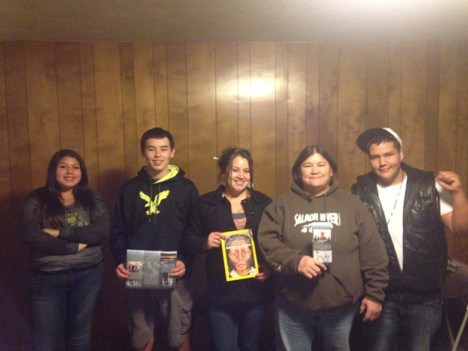
Source: Intercontinental Cry
Orleans, CA – Local youth are making plans to travel to Brazil to lend a hand in the fight against the world’s most destructive dam proposal, Belo Monte. The Belo Monte Dam Resistance Delegation includes indigenous tribes and river activists from Northern California who will travel to Brazil to work with indigenous people in the Xingu basin, the heart of the Amazon, making a strong bond through mutual efforts to preserve and protect inherited cultures and natural resources from short sighted projects like the Belo Monte Dam.
The Belo Monte project, would be the third largest hydroelectric dam ever built. This project would affect 40,000 people and inundate 640 square kilometers of rainforest. Belo Monte Dam is the first step in a larger plan to extract the Amazon’s vast resources through additional dam building.
Belo Monte is one of many dams proposed for the Amazon that would affect hundreds of thousands of indigenous people, including some of the world’s last un-contacted tribes, allowing further destructive mining and deforestation practices. The Amazon Basin, about the size of the continental U.S., is home to 60 percent of the world’s remaining rainforest, and holds one-fifth of the world’s fresh water.
In Northern California and Southern Oregon a diverse coalition of Native Americans and river activists have campaigned for the removal of four dams on the Klamath River. Currently, dozens of key Klamath Basin stakeholders, including dam owner PacifiCorp, have agreed to remove 4 Klamath River dams pending congressional action.
This project represents the largest dam removal in world history and is poised to restore one of North America’s largest salmon runs, allowing indigenous people to repair broken cultures and communities.
Our delegation will discuss the correlation between the struggles of indigenous people of the Amazon, and the lessons of indigenous struggles in North America, as well as the environmental hazards that dams have caused in the Klamath Basin. Native youth activists that have long fought for their culture will travel to the Amazon to learn about indigenous struggles in the Amazon Basin, engaging lifelong partners for the protection of the Amazon and its indigenous people.
According to Mahlija Florendo, a 16 year old Yurok Tribal member who will be going to the Amazon, “Our River is here to give us life, and we were created to keep the river beautiful and healthy. We need to keep every river alive because we cannot live without them. We cannot destroy life and if we don’t fight to keep them healthy, then we are killing ourselves, and any other life on the planet. The Amazon River is a huge bloodline for life of the Amazon indigenous as the Klamath is ours.”
Amazon Watch’s Brazil Program Coordinator, who knows the area, issues, and people, will accompany the delegation, providing guidance and on the ground support. Along with documenting the early stages of dam construction, the group plans to meet with several local tribes such as the Arara, Juruna, and the Xikrin, learning how they can best support efforts to preserve their homeland and way of life.
The Klamath group will connect Native Americans and grassroots activists from North America with tribes and organizations working in the Amazon to help them maintain their unique, rare and endemic cultures. They hope to return to the U.S. with information and firsthand knowledge to hold fundraising and advocacy events. These efforts will raise money for existing Belo Monte resistance groups and local tribes to travel and deliver their message to venues like the upcoming World Cup in Brazil in June and July 2014.
In the words of Zé Carlos Arara, a leader of the Arara people, “For us the river means many things. For everything we do, we depend on the river. For us to go out, to take our parents around, to get medical attention, we need the river for all these things. If a dam is constructed on the river, how will we pass through it? We don’t want to see the river closed off, our parents dying in inactivity. For us the river is useful and we don’t want it to wither away – that we not have a story to tell, that it become a legend for our children and grandchildren. We want them to see it with their own eyes.”
Keystone XL ‘black snake’ pipeline to face ‘epic’ opposition from Native American alliance
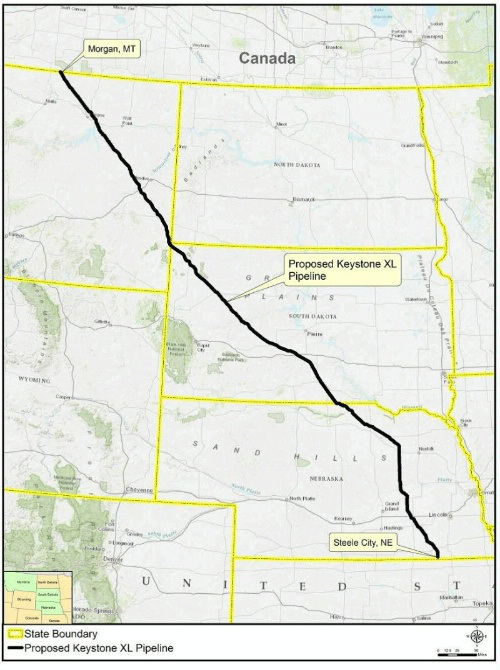
By Jorge Barrera, January 31, 2014. Source: APTN National News
A Native American alliance is forming to block construction of TransCanada’s proposed Keystone XL pipeline which still needs final approval from U.S. President Barack Obama after the State Department released an environmental report indicating the project wouldn’t have a significant impact Alberta tar sands production.
Members from the seven tribes of the Lakota Nation, along with tribal members and tribes in Idaho, Oklahoma, Montana, Nebraska and Oregon, have been preparing to stop construction of the 1,400 kilometre pipeline which is slated to run, on the U.S. side, from Morgan, Mon., to Steel City, Neb., and pump 830,000 barrels per day from Alberta’s tar sands. The pipeline would originate in Hardisty, Alta.
“It poses a threat to our sacred water and the product is coming from the tar sands and our tribes oppose the tar sands mining,” said Deborah White Plume, of the Oglala Sioux Tribe, which is part of the Lakota Nation in South Dakota. “All of our tribes have taken action to oppose the Keystone XL pipeline.”
The U.S. State Department released its long awaited environmental report on TransCanada’s proposed pipeline Friday. The report found that the pipeline’s operation would not have a major impact on Alberta tar sands production which is also at the mercy of market forces.
“Approval or denial of any one crude oil transport project, including the proposed project, is unlikely to significantly impact the rate of extraction in the oil sands or the continued demand for heavy crude oil at refineries in the United States based on expected oil prices, oil sand supply costs, transport costs and supply-demand scenarios,” said the report.
The project will now go into a final phase which focuses on whether Keystone XL “serves the national interest.” Pipeline’s environmental, cultural and economic impacts will be weighed in this phase and at least eight agencies will have input on the outcome, including the Department Defence, Justice, Interior, Commerce, Transportation, Energy, Homeland Security and the Environmental Protection Agency.
A 30-day public comment period will also be initiated on Feb. 5.
The State Department is also in the midst of probing conflict-of-interest allegations levelled against contractors who both worked on the report and for TransCanada.
The Lakota Nation is preparing for the eventuality the pipeline receives approval. The nation has led the formation of a project called “Shielding the People” to stop the pipeline. The Lakota also launched a “moccasins on the ground” program to train people in Indigenous communities to oppose the pipeline.
There are also plans to set up spiritual camps along the pipeline’s route. But when and where those camps will spring up remains a closely guarded secret.
“It will band all Lakota to live together and you can’t cross a living area if it’s occupied,” said Greg Grey Cloud, of the Rosebud Sioux Tribe. “If it does get approved we aim to stop it.”
Gary Dorr, from the Nez Perce Tribe in Idaho, was in Rosebud Friday for a meeting to discuss opposition to Keystone.
The Nez Perce tribe has already used its treaty rights to block the transport of so-called megaloads of mining equipment headed to Alberta’s tar sands through its territory. The tribe launched blockades and won a court battle to stop the shipments from traversing its lands.
“It will be obvious, it will be concrete, and I think once it starts and they start building you will start to see the momentum and the force of the tribal people…it is an epic project, it will have an epic response from the tribal people,” said Dorr. “The tar sands is already affecting the people (for Fort Chipewyan in Alberta), climate change is already obvious. To facilitate that is not something the Native people of the U.S. are going to do. We are not going to sit idly by and let it happen.”
The pipeline has been called the ‘black snake’ in reference to prophecies that had previously been linked to construction of highways and railways. In recent ceremonies, however, discussions sifting through the prophecies noted that the black snake goes under ground.
“That would be a referral to the pipeline,” said Dorr.
Paula Antoine, who works for the Rosebud Tribe’s land office, said while the pipeline does not cross any Lakota reservation lands, it comes close, sometimes metres away. Antoine said the pipeline, however, cuts through their treaty territory, sacred sites and waterways.
“They aren’t recognizing our treaties, they are violating our treaty rights and our boundaries by going through there,” said Antoine. “Any ground disturbance around that proposed line will affect us.”
The battle lines have already been drawn in tribal council chambers. The Oglala Sioux Tribe passed a resolution Friday banning TransCanada and former AFN national chief Phil Fontaine, who has been hired by the energy firm to deal with First Nations opposition to its Energy East project in Canada, from entering its territory.
The resolution received unanimous consent,said White Plume.
The Lakota, Dakota and Nakota make up the Lakota Nation. The nation includes the tribes of Rosebud, Oglala and the Cheyenne Indian reservation, the Yankton Sioux Tribe, Standing Rock, Flandreau Sioux Tribe and the Crow Creek Sioux Tribe.




